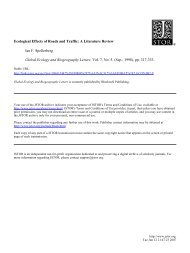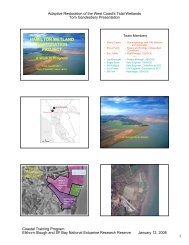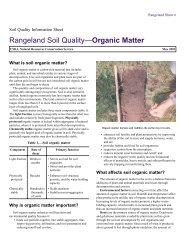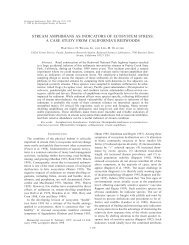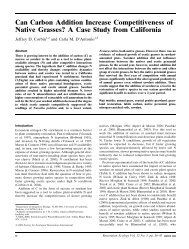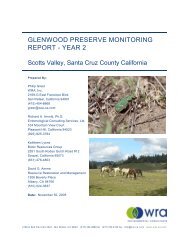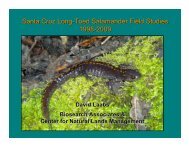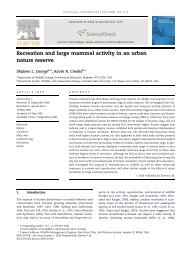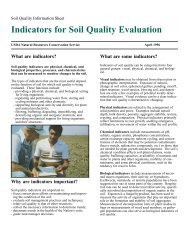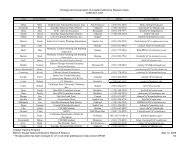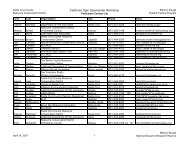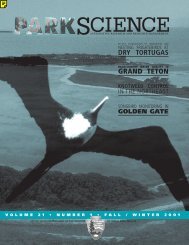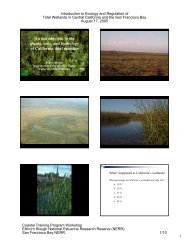BIRD POPULATIONS - Birdpop.org
BIRD POPULATIONS - Birdpop.org
BIRD POPULATIONS - Birdpop.org
- No tags were found...
Create successful ePaper yourself
Turn your PDF publications into a flip-book with our unique Google optimized e-Paper software.
ROBERT L. WILKERSON AND RODNEY B. SIEGELour “best estimate” for owl pairs in the lowlandsubregion. No Burrowing Owls were detectedon the four randomly-selected upland blocks, soour random-sample based population estimatefor the upland subregion is zero pairs. However,we found 37 pairs on upland historic breedingblocks, so our “best estimate” for the uplandsubregion is the actual number of pairs wefound: 37. Summing our estimate from thelowland subregion and our count on the uplandblocks surveyed, our estimate for the CoachellaValley region is 53 pairs, a remarkable changefrom the 1991-1993 estimate of zero pairs (Table4). Four historic breeding blocks (two uplandblocks at the northern end of the region plus anadditional upland and lowland block furthersouth), in which we found multiple pairs, werealso surveyed in the early 1990s (then alsoselected as random blocks), when no owls weredetected. These results suggest the blocks mayhave been colonized since the 1991-1993 survey.IMPERIAL VALLEYWe surveyed seven randomly-selected blocksand eight historic breeding blocks in this region(Fig. 11). Surveys of random blocks yielded 271Burrowing Owl pairs, and surveys of historicbreeding blocks yielded 250 pairs, for a total of521 pairs detected.In the five randomly-selected lowland blockssurveyed, we found 254 pairs, yielding arandom-sample based estimate of 5,701 ± 2,244pairs throughout the lowland subregion. Thisestimate was greater than the total number ofpairs found in the lowland subregion (254 pairson randomly-selected blocks plus 245 pairs onhistoric breeding blocks), so it serves as our“best estimate” for pairs in the lowland subregion.In the two randomly-selected uplandblocks surveyed, we found 17 pairs of owls,yielding a random-sample based estimate of 707± 140 pairs throughout the upland subregion.This estimate was greater than the number ofpairs we found in the upland subregion (17pairs in randomly-selected blocks plus five pairsin historic breeding blocks), so it serves as our“best estimate” in the upland subregion.Summing our estimates for the lowland andupland subregions, our estimate for the ImperialValley region is 6,408 ± 2,384 pairs, 2.5% fewerthan the 6,571 pairs estimated during the 1991-1993 survey (Table 4), a statistically insignificantdecline (F1,12 = 0.3163, P = 0.584).MODOC PLATEAU/GREAT BASINWe surveyed 13 randomly-selected blocks, andtwo historic breeding blocks in this region (Fig.12). All blocks surveyed were classified asupland blocks, because the entire bioregion lieswell above the upper bound of the lowerelevation zones for all of our other surveyregions.We detected no Burrowing Owls on randomblocks or historic breeding blocks, so our “bestestimate” for the number of pairs in the region iszero pairs. Subsequent to our survey, breedinghas been observed in Sierra Valley as recently as2009 (Richard Carlson, pers. comm.), althoughinformation is lacking to determine whether thisbreeding location was active during 2006-2007when we conducted our field work.NORTHERN MOJAVE DESERT/EASTERN SIERRA NEVADAWe surveyed 36 randomly-selected blocks andtwo historic breeding blocks in this region; noneof them yielded Burrowing Owl detections.However, one pair was detected incidentally onan otherwise unsurveyed block (see Wilkersonand Siegel, in press, for additional details).WESTERN MOJAVE DESERTWe surveyed 48 randomly-selected blocks and19 historic breeding blocks in this region. Our“best estimate”, based on 25 pairs of owlsdetected on 42 pairs of owls detected on therandom blocks, is 560 ± 268 pairs (see Wilkersonand Siegel, in press, for additional details).EASTERN MOJAVE DESERTWe surveyed 43 randomly-selected blocks andtwo historic breeding blocks in the EasternMojave Desert region. Our “best estimate” forthe region, based on one pair of owls detectedon the randomly-selected blocks, is 32 ± 32 pairs(see Wilkerson and Siegel, in press, for additionaldetails).SONORAN DESERTWe surveyed 31 randomly-selected blocks, and16 historic breeding blocks in the SonoranDesert region. Our “best estimate” for theregion, based on 179 pairs of owls detected[24]



